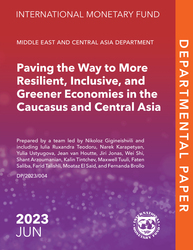
Paving the Way to More Resilient, Inclusive, and Greener Economies in the Caucasus and Central Asia
This paper argues that a more market-based allocation of limited resources is needed to channel capital and labor to their most productive use.
Volume/Issue:
Volume 2023
Issue 004
Publication date: June 2023
ISBN: 9798400239175
$20.00
Add to Cart by clicking price of the language and format you'd like to purchase
Available Languages and Formats
| English | |||
| Russian |
Prices in red indicate formats that are not yet available but are forthcoming.
Topics covered in this book
This title contains information about the following subjects.
Click on a subject if you would like to see other titles with the same subjects.
International - Economics , Public Policy , Caucasus and Central Asia , Structural Reforms , Governance , Inclusive Growth , Climate policy , Social safety nets
Summary
Raising long-term growth and resilience and improving living standards and inclusion are the top economic policy priorities for countries in the Caucasus and Central Asia (CCA). The region responded strongly to the COVID shock, which unavoidably caused a contraction in output and an increase in poverty and inequality. While the region is at the crossroads between the West and the East as it is facing heightened uncertainty due to Russia’s war in Ukraine and the rising risk of global fragmentation. Climate change is an additional challenge that could have a significant negative impact on CCA countries in the long term. These challenges, however, also offer an opportunity for the region to develop a new growth model that could strengthen long-term resilience, accelerate income convergence with more advanced country peers, and improve human development and social outcomes. The paper argues that a more market-based allocation of limited resources is needed to channel capital and labor to their most productive use. The private sector needs to become a key driver of economic activity while the state provides a competitive and market-friendly business environment, delivers essential public goods and services, addresses externalities and market failures, and mitigates systemic risks. The state also retains a critical role in mobilizing public support and resources for climate policies and protecting the vulnerable. Well-designed social safety nets play a key role in reducing poverty and inequality and are essential to the new economic growth model to support human capital development and alleviate the impact of structural reforms on the most vulnerable.
Copyright © 2010 - 2025
Powered by:
AIDC



